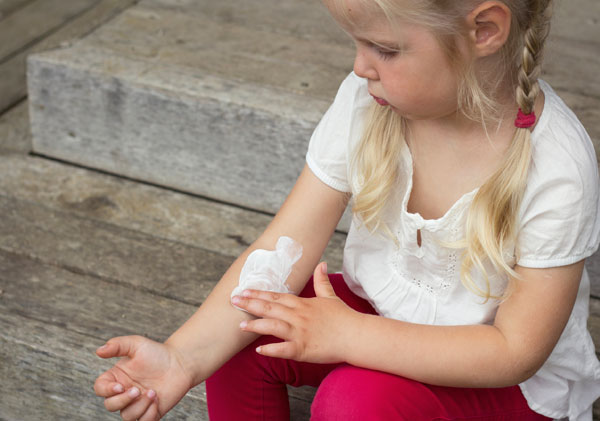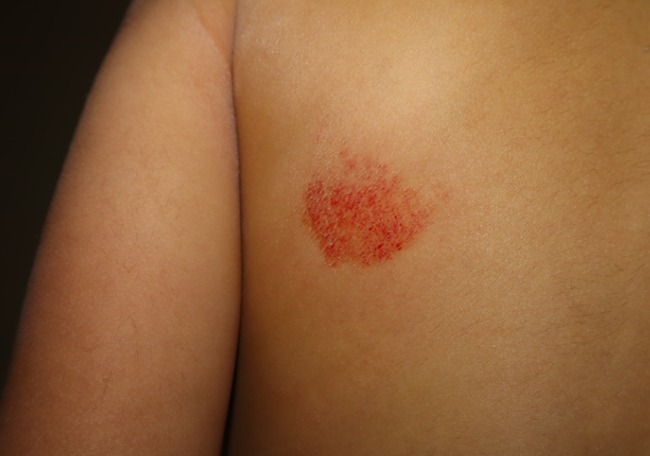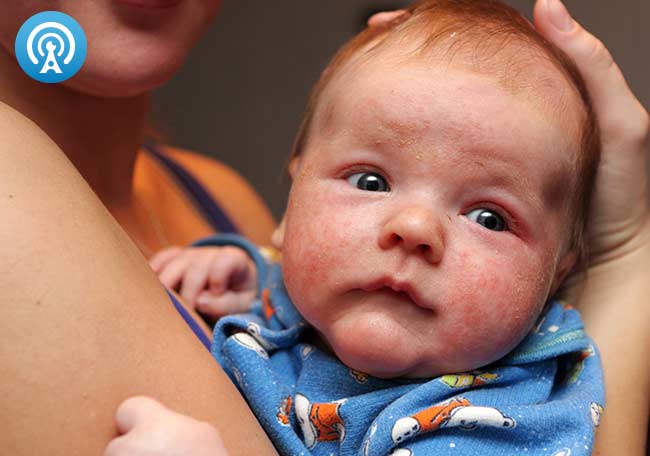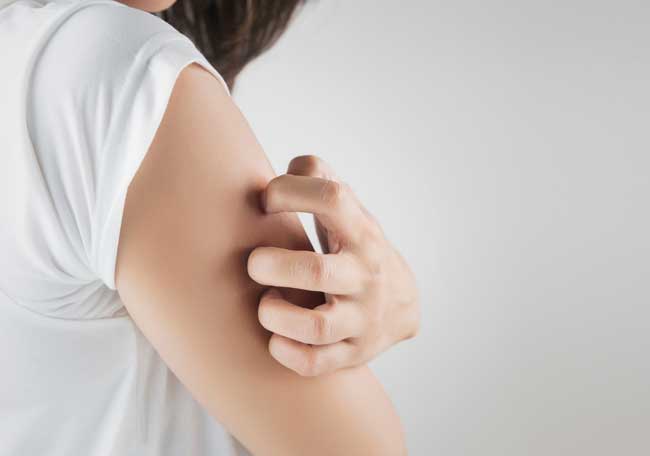Guías de manejo para dermatitis atópica

1. Jackson KD, Howie LD, Akinbami LJ. Trends in Allergic Conditions Among Children: United States, 1997–2011. NCHS Data Brief, No. 121. Hyattsville, MD: National Center for Health Statistics; 2013
2. Silverberg JI, Simpson EL. Association between severe eczema in children and multiple comorbid conditions and increased healthcare utilization. Pediatr Allergy Immunol. 2013;24(5):
476–486
3. Saavedra JM, Boguniewicz M, Chamlin S, et al. Patterns of clinical management of atopic dermatitis in infants and toddlers: a survey of three physician specialties in the United States. J Pediatr. 2013;163(6): 1747–1753
4. Hanifin JM, Cooper KD, Ho VC, et al. Guidelines of care for atopic dermatitis, developed in accordance with the American Academy of Dermatology (AAD)/American Academy of Dermatology Association “Administrative Regulations for Evidence-Based Clinical Practice Guidelines”. J Am Acad Dermatol. 2004;50(3):391–404
5. Leung DY, Nicklas RA, Li JT, et al. Disease management of atopic dermatitis: an updated practice parameter. Joint Task Force on Practice Parameters. Ann Allergy Asthma Immunol. 2004;93(3 suppl2):S1–S21
6. Akdis CA, Akdis M, Bieber T, et al; European Academy of Allergology; Clinical Immunology/American Academy of Allergy, Asthma and Immunology/PRACTALL Consensus Group. Diagnosis and treatment of atopic dermatitis in children and adults: European Academy
of Allergology and Clinical Immunology/American Academy of Allergy, Asthma and Immunology/PRACTALL Consensus Report. Allergy. 2006;61(8):969–987
7. Ring J, Alomar A, Bieber T, et al; European Dermatology Forum; European Academy of Dermatology and Venereology; European Task Force on Atopic Dermatitis; European Federation of Allergy; European Society of Pediatric Dermatology; Global Allergy and Asthma European Network.
Guidelines for treatment of atopic eczema (atopic dermatitis) Part II. J Eur Acad Dermatol Venereol. 2012; 26(9):1176–1193
8. Ring J, Alomar A, Bieber T, et al; European Dermatology Forum (EDF); European Academy of Dermatology and Venereology (EADV); European Federation of Allergy (EFA); European Task Force on Atopic Dermatitis (ETFAD); European Society of Pediatric Dermatology (ESPD); Global Allergy and Asthma European Network (GA2LEN).
Guidelines for treatment of atopic eczema (atopic dermatitis) part I. J Eur Acad Dermatol Venereol. 2012;26(8): 1045–1060
9. Schneider L, Tilles S, Lio P, et al Atopic dermatitis: a practice parameter update 2012. J Allergy Clin Immunol. 2013; 131(2):295–299
10. Eichenfield LF, Tom WL, Chamlin SL, et al. Guidelines of care for the management of atopic dermatitis: section 1. Diagnosis and assessment of atopic dermatitis. J Am Acad Dermatol. 2014;
70(2):338–351
11. Eichenfield LF, Tom WL, Berger TG, et al. Guidelines of care for the management of atopic dermatitis: section 2. Management and treatment of atopic dermatitis with topical therapies. J Am Acad Dermatol. 2014;71(1):116–132
12. Sidbury R, Davis DM, Cohen DE, et al; Guidelines of care for the management of atopic dermatitis: section 3. Management and treatment withphototherapy and systemic agents.
J Am Acad Dermatol. 2014;71(2):327–349
13. Sidbury R, Tom WL, Bergman JN, et al. Guidelines of care for the management of atopic dermatitis: Section 4. Prevention of disease flares and use of adjunctive therapies and approaches. JAm Acad Dermatol. 2014;71(6):1218–1233
14. Eichenfield LF, Hanifin JM, Luger TA, Stevens SR, Pride HB. Consensus conference on pediatric atopic dermatitis. J Am Acad Dermatol. 2003; 49(6):1088–1095
15. Rajka G, Langeland T. Grading of the severity of atopic dermatitis. Acta Derm Venereol Suppl (Stockh). 1989;144:13–14
16. Langan SM, Thomas KS, Williams HC. What is meant by a “flare” in atopic dermatitis? A systematic review and proposal. Arch Dermatol. 2006;142(9):1190–1196
17. Paller AS, Mancini AJ. Eczematous eruptions in childhood. In: Paller AS, Mancini AJ, eds. Hurwitz Clinical Pediatric Dermatology, 4th ed, Chapter 3. St. Louis, MO: Elsevier, Inc; 2011:49
18. Breneman D, Fleischer AB Jr, Abramovits W, et al; Tacrolimus Ointment Study Group. Intermittent therapy for flare prevention and long-term disease control in stabilized atopic dermatitis:
a randomized comparison of 3-timesweekly applications of tacrolimus ointment versus vehicle. J Am Acad Dermatol. 2008;58(6):990–999
19. Paller AS, Eichenfield LF, Kirsner RS, Shull T, Jaracz E, Simpson EL; US Tacrolimus Ointment Study Group. Three times weekly tacrolimus ointment reduces relapse in stabilized atopic dermatitis: a new paradigm for use. Pediatrics. 2008;122(6). Available at: www.pediatrics. org/cgi/content/full/122/6/e1210
20. Thaçi D, Reitamo S, Gonzalez Ensenat MA, et al; European Tacrolimus Ointment Study Group. Proactive disease management with 0.03% tacrolimus ointment for children with atopic dermatitis: results of a randomized, multicentre, comparative study. Br J Dermatol. 2008;159(6):1348–1356
21. Wollenberg A, Reitamo S, Atzori F, et al; European Tacrolimus Ointment Study Group. Proactive treatment of atopic dermatitis in adults with 0.1% tacrolimus ointment. Allergy. 2008;63(6):
742–750
22. Hanifin J, Gupta AK, Rajagopalan R. Intermittent dosing of fluticasona propionate cream for reducing the risk of relapse in atopic dermatitis patients. Br J Dermatol. 2002;147(3):528–537
23. Schmitt J, von Kobyletzki L, Svensson A, Apfelbacher C. Efficacy and tolerability of proactive treatment with topical corticosteroids and calcineurin inhibitors for atopic eczema: systematic review and meta-analysis of randomized controlled trials. Br J Dermatol. 2011; 164(2):415–428
24. Reitamo S, Allsopp R. Treatment with twice-weekly tacrolimus ointment in patients with moderate to severe atopic dermatitis: results from two randomized, multicentre, comparative studies. J Dermatolog Treat. 2010;21(1): 34–44
25. Hengge UR, Ruzicka T, Schwartz RA, Cork MJ. Adverse effects of topical glucocorticosteroids. J Am Acad Dermatol. 2006;54(1):1–15, quiz 16–18
26. Garg N, Silverberg JI. Association between childhood allergic disease, psychological comorbidity, and injury requiring medical attention. Ann Allergy Asthma Immunol. 2014;112(6):525–532
27. Schmitt J, Buske-Kirschbaum A, Roessner V. Is atopic disease a risk factor for attention-deficit/hyperactivity disorder? A systematic review. Allergy. 2010;65(12):1506–1524
28. Romanos M, Gerlach M, Warnke A, Schmitt J. Association of attention-deficit/hyperactivity disorder and atopic eczema modified by sleep disturbance in a large population-based sample. J Epidemiol Community Health. 2010;64(3):269–273
29. Schmitt J, Chen CM, Apfelbacher C, et al; LISA-plus Study Group. Infant eczema, infant sleeping problems, and mental health at 10 years of age: the prospective birth cohort study LISAplus. Allergy. 2011;66(3):404–411
30. Yaghmaie P, Koudelka CW, Simpson EL. Mental health comorbidity in patients with atopic dermatitis. J Allergy ClinImmunol. 2013;131(2):428–433
31. Kelsay K. Management of sleep disturbance associated with atopic dermatitis. J Allergy Clin Immunol. 2006; 118(1):198–201
32. Kaufmann R, Fölster-Holst R, Höger P, et al; CASM981CDE04-Study Group. Onset of action of pimecrolimus cream 1% in the treatment of atopic eczema in infants. J Allergy Clin Immunol. 2004; 114(5):1183–1188
33. Bieber T, Vick K, Fölster-Holst R, et al. Efficacy and safety of methylprednisolone aceponate ointment 0.1% compared to tacrolimus 0.03% in children and adolescents with an acute flare of severe atopic dermatitis. Allergy 2007;62(2):184–189
34. Doss N, Kamoun MR, Dubertret L, et al. Efficacy of tacrolimus 0.03% ointment as second-line treatment for children with moderate-to-severe atopic dermatitis: evidence from a randomized, double-blind noninferiority trial vs. fluticasone 0.005% ointment. Pediatr Allergy Immunol. 2010;21(2 pt 1):321–329
35. Mason JM, Carr J, Buckley C, et al.Improved emollient use reduces atopic eczema symptoms and is cost neutral in infants: before-and-after evaluation of a multifaceted educational support programme. BMC Dermatol. 2013;13:7
36. Stewart AC, Thomas SE. Hypnotherapy as a treatment for atopic dermatitis in adults and children. Br J Dermatol. 1995; 132(5):778–783
37. Shani-Adir A, Rozenman D, Kessel A, Engel-Yeger B. The relationship between sensory hypersensitivity and sleep quality of children with atopic dermatitis. Pediatr Dermatol. 2009;26(2):
143–149
38. Eichenfield LF, Mancini AJ. Personal Care Plan. Semin Cutan Med Surg. 2012;31 (3S):30–31
39. Huang JT, Abrams M, Tlougan B, Rademaker A, Paller AS. Treatment of Staphylococcus aureus colonization in atopic dermatitis decreases disease severity. Pediatrics. 2009;123(5). Available at: www.pediatrics.org/cgi/content/full/123/5/e808
40. Ryan C, Shaw RE, Cockerell CJ, Hand S, Ghali FE. Novel sodium hypochlorite cleanser shows clinical response and excellent acceptability in the treatment of atopic dermatitis. Pediatr Dermatol. 2013;30(3):308–315
41. Fritz SA, Camins BC, Eisenstein KA, et al. Effectiveness of measures to eradicate Staphylococcus aureus carriage in patients with community-associated skinand soft-tissue infections: a randomized trial. Infect Control Hosp Epidemiol. 2011; 32(9):872–880
42. Krakowski AC, Eichenfield LF, Dohil MA. Management of atopic dermatitis in the pediatric population. Pediatrics. 2008; 122(4):812–824. Available at: http://pediatrics.aappublications.org/content/122/4/812
43. Nicol NH, Boguniewicz M, Strand M, Klinnert MD. Wet wrap therapy in children with moderate to severe atopic dermatitis in a multidisciplinary treatment program. J Allergy Clin Immunol Pract. 2014;2(4):400–406
44. Long CC, Finlay AY. The finger-tip unit—a new practical measure. Clin Exp Dermatol. 1991;16(6):444–447
45. Long CC, Mills CM, Finlay AY. A practical guide to topical therapy in children. Br JDermatol. 1998;138(2):293–296
46. Luersen K, Davis SA, Kaplan SG, Abel TD, Winchester WW, Feldman SR. Sticker charts: a method for improving adherence to treatment of chronic diseases in children. Pediatr Dermatol.
2012;29(4):403–408
MORE
Comentarios
Para ver los comentarios de sus colegas o para expresar su opinión debe ingresar con su cuenta de IntraMed.

















